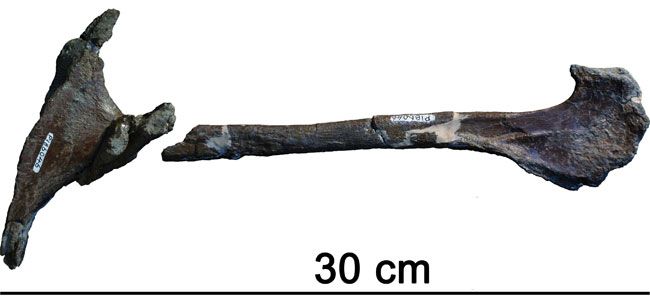Tiny Tyrannosaur Came from the Land Down Under

T-rex's relatives might have once roamed in the land Down Under, according to a new study. A pelvic bone uncovered in Australia marks the first evidence that tyrannosaurs could have inhabited the Southern Hemisphere.
Until now, all the remains from tyrannosauroids — the lineage of dinosaurs that includes the famous Tyrannosaurus rex — have been restricted to northern continents like Asia and North America, leading some paleontologists to believe these dinosaurs never lived down south, said study author Roger Benson of University of Cambridge in England. But the new finding suggests tyrannosaurs could have had a global distribution.
"It helps us to fill in a gap in the geography of tyrannosaurs," Benson said.
At 110 million years old, the fossil comes from an animal that lived about 40 million years before T. rex.
And the scientists think this proposed southern relative was much smaller than T. rex, weighing in at about 175 pounds (80 kilograms), in comparison to T. rex's 6 tons. But the animal would have appeared as a scaled-down version of its gigantic cousin, similar to the "mini T.rex" or Raptorex kriegsteini that was announced last September, Benson said.
Based on the presented evidence, the fossil appears to be from a tyrannosaur, said Thomas Carr, a professor at Carthage College in Wisconsin, who studies tyrannosaurs and was not involved in the current study. However, Carr notes that at this point, it's still a hypothesis that will need to be backed up by further research. For instance, other groups of scientists will have to independently verify the results, he said.
If true, the findings provide new insights into the evolutionary history of these dinosaurs.
Sign up for the Live Science daily newsletter now
Get the world’s most fascinating discoveries delivered straight to your inbox.
"This is a sliver of a window into the southern forms, and we haven't had that, it's been a blank slate until now," Carr said.
The results will be published March 26 in the journal Science.
Distinctive bone
Although the finding is based only on one bone — the pubis, one of three bones that make up the pelvis — it's still possible to distinguish the fossil as belonging to a tyrannosaur, Benson said.
"It's basically virtually identical to the pubis of a tyrannosaurid like T. rex, apart from the fact that it's much smaller in size," he said.
For instance, one end of the 12-inch (30 centimeter) long bone is expanded and looks like a boot, which is strongly characteristic of tyrannosaurs, Benson said. The other end, which is flattened and connects to the hip, also has features that are very distinctive of these dinosaurs, he said.
Roaming down south
While the tyrannosauroid lineage spans some 100 million years, researchers are only just starting to learn about the groups' early history.
Fossil evidence suggests tyrannosaurs were present on Pangaea, the supercontinent that existed some 200 million years ago, Carr said.
"I think in some workers' minds, there's been an expectation that tyrannosauroids at some point would be found in the southern hemisphere," he said
Around 110 million years ago, the northern continents would have already separated from the southern continents, Benson said. So based on this fossil, tyrannosaurs must have achieved a global distribution before the northern and southern continents separated, he said.
The finding also raises new questions about tyrannosaurs, such as, if they did inhabit the south, what happened to them?
"In the Southern Hemisphere…by the end of the history of dinosaurs, there's no trace of them, and they definitely didn't become these gigantic predators like they did in the northern hemisphere," Benson said. Future discoveries could help researchers understand how the dinosaurs' fate was so different in the two hemispheres.
Also, the findings might prompt some scientists that study southern dinosaurs to go back and look at fossils to see whether they are tyrannosaur or not, Carr said.
- Man-Sized Dino Was a Tiny T. Rex
- New Tyrannosaur Species Discovered
- Image Gallery: Dinosaur Fossils

Rachael is a Live Science contributor, and was a former channel editor and senior writer for Live Science between 2010 and 2022. She has a master's degree in journalism from New York University's Science, Health and Environmental Reporting Program. She also holds a B.S. in molecular biology and an M.S. in biology from the University of California, San Diego. Her work has appeared in Scienceline, The Washington Post and Scientific American.











